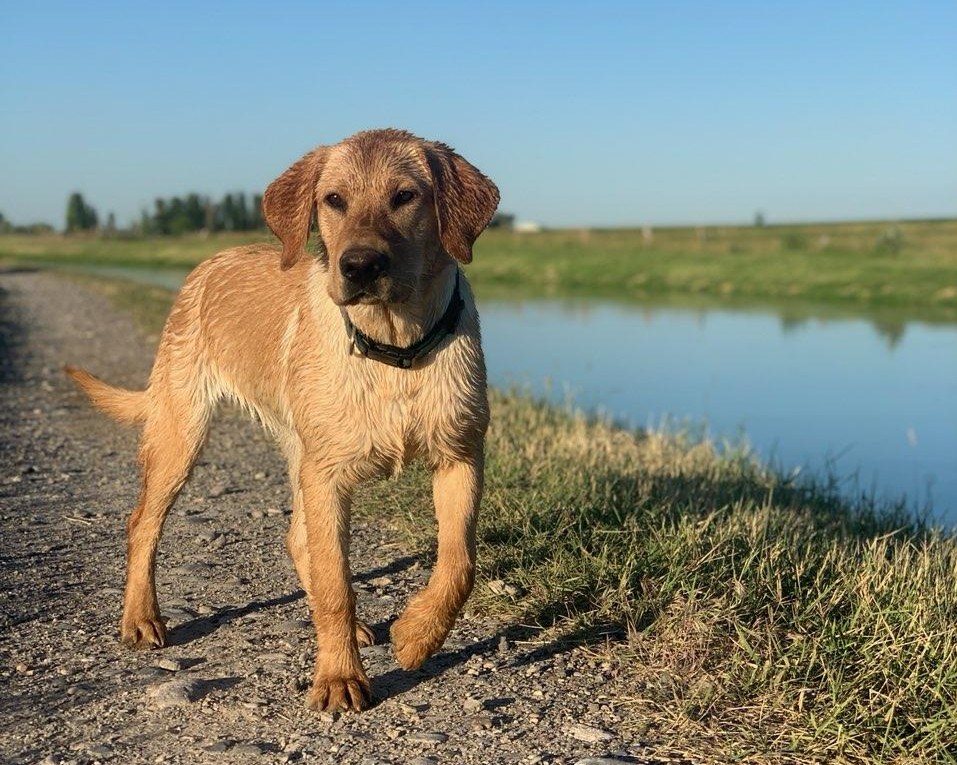
Understanding the Role of the E-Locus Gene in Yellow Labrador Retriever
Labrador Retrievers are one of the most popular dog breeds globally, known for their friendly nature and versatile abilities. They come in three primary colors: black, chocolate, and yellow. The coat color in Labradors is determined by various genes, and one of the critical genes responsible for yellow coat color is the E-locus gene. In this blog, we will explore the role of the E-locus gene in yellow Labradors and how different genetic crosses affect the coat color of their offspring.
Section 1: The Role of the E-Locus Gene in Yellow Labradors
The E-locus gene, also known as the extension gene, plays a significant role in determining the coat color of Labradors. This gene controls the production of eumelanin (black or brown pigment) in the dog’s coat. The E-locus gene has two main alleles: E (dominant) and e (recessive).
- E allele: Allows the production of eumelanin, resulting in black or chocolate Labradors, depending on other genetic factors.
- e allele: Prevents the production of eumelanin, leading to a yellow coat color.
For a Labrador to have a yellow coat, it must inherit two copies of the recessive e allele (ee) from its parents. This means that both parents must carry at least one e allele for their offspring to be yellow.
Yes, yellow Labradors come in a variety of shades, ranging from a pale cream or almost white color to a rich, dark golden hue. Here are the common shades:
- Pale Cream/White: Very light, almost white in appearance.
- Light Yellow: A soft, pale yellow, often described as “blonde.”
- Yellow: A medium yellow color, which is the most typical and commonly seen shade.
- Dark Yellow/Golden: A richer, deeper golden yellow color.
If you have a specific shade in mind, I can adjust the image to match that particular color. Let me know which shade you’d prefer!
The different shades of yellow in Labradors are primarily influenced by genetics. Here’s a detailed explanation:
- Genetics: The primary factor that determines the shade of a yellow Labrador’s coat is the genetic makeup inherited from its parents. The specific genes involved include the B (black/brown) locus and the E (extension) locus.
- E Locus: This locus controls the production of the pigment eumelanin, which can result in a black or brown coat. When a dog has two recessive alleles (ee) at the E locus, it will produce a yellow coat, as the eumelanin pigment is suppressed.
- Modifiers: Within the yellow coat category, other genetic modifiers influence the exact shade of yellow. These modifiers can lighten or darken the coat, leading to the range of shades from pale cream to dark golden.
- Breeding Practices: Breeders often select for specific coat colors and shades. By selectively breeding dogs with desirable coat colors, they can enhance the likelihood of producing puppies with similar shades.
- Environmental Factors: While genetics play the most significant role, environmental factors such as sun exposure can also affect a Labrador’s coat color. Prolonged exposure to sunlight can lighten the coat, while less exposure might result in a darker appearance.
- Age: A Labrador’s coat color can change slightly with age. Puppies might be born with a lighter or darker coat that changes as they grow older.
Different shades of yellow Labradors are a natural result of the interplay between genetic factors and, to a lesser extent, environmental influences.
Crossing a Yellow Labrador with Another Yellow Labrador
When two yellow Labradors are crossed, they both have the genotype ee. Since they can only pass on the e allele, all of their offspring will inherit the ee genotype. Therefore, every puppy in the litter will be yellow.
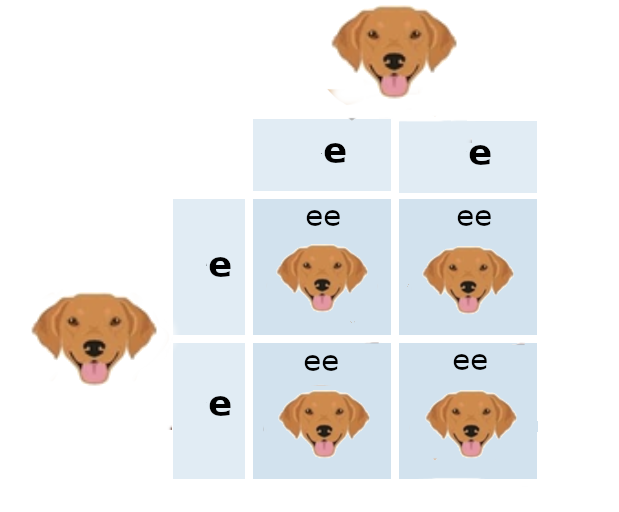
- Genotype of parents: ee (yellow) x ee (yellow)
- Possible genotype of offspring: 100% ee (yellow)
- Chance of producing yellow Labradors: 100%
- Chance of offspring being carriers of the E-locus gene: 0% (All are yellow with the ee genotype)
Crossing a Yellow Labrador with a Carrier of the E-Locus Gene
A Labrador that is a carrier of the E-locus gene has one E allele and one e allele (Ee). When this dog is crossed with a yellow Labrador (ee), the possible offspring can have a variety of genotypes.
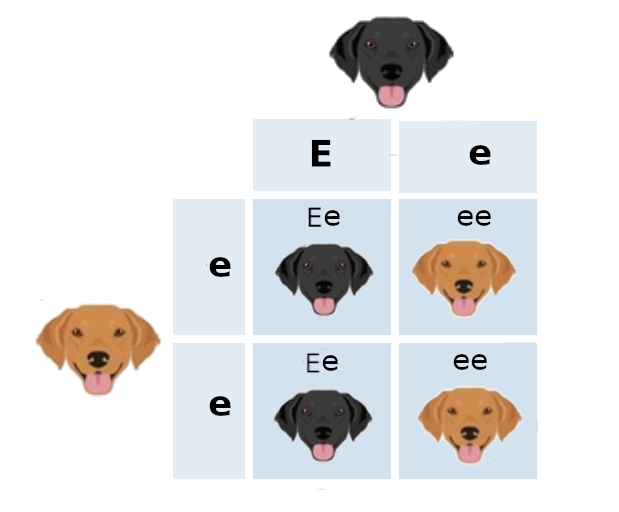
- Genotype of parents: ee (yellow) x Ee (carrier)
- Possible genotypes of offspring:
- 50% Ee (carriers, black or chocolate)
- 50% ee (yellow)
- Chance of producing yellow Labradors: 50%
- Chance of offspring being carriers of the E-locus gene: 50%
Crossing a Yellow Labrador with a Labrador That Doesn’t Carry the E-Locus Gene
A Labrador that does not carry the E-locus gene has the genotype EE. When crossed with a yellow Labrador (ee), the resulting puppies will all inherit one E allele from the EE parent and one e allele from the ee parent.
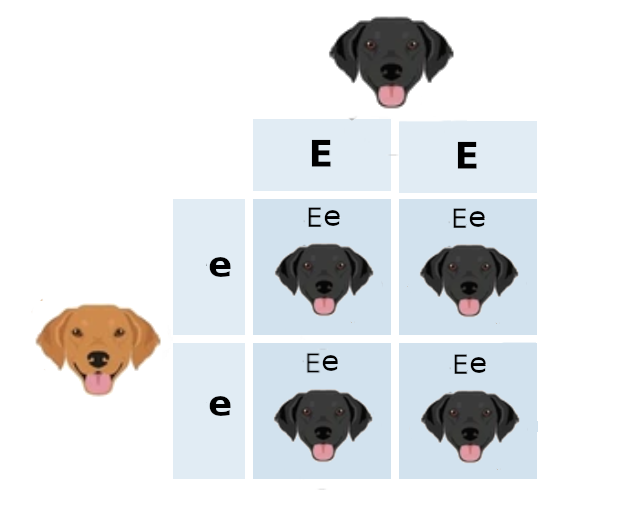
- Genotype of parents: ee (yellow) x EE (non-carrier)
- Possible genotype of offspring: 100% Ee (carriers, black or chocolate)
- Chance of producing yellow Labradors: 0%
- Chance of offspring being carriers of the E-locus gene: 100%
Crossing a Labrador That Is a Carrier of the E-Locus Gene with Another Carrier
When two Labradors that are carriers of the E-locus gene (both having the genotype Ee) are crossed, their offspring can inherit various combinations of the E and e alleles. This results in three possible genotypes among the puppies.
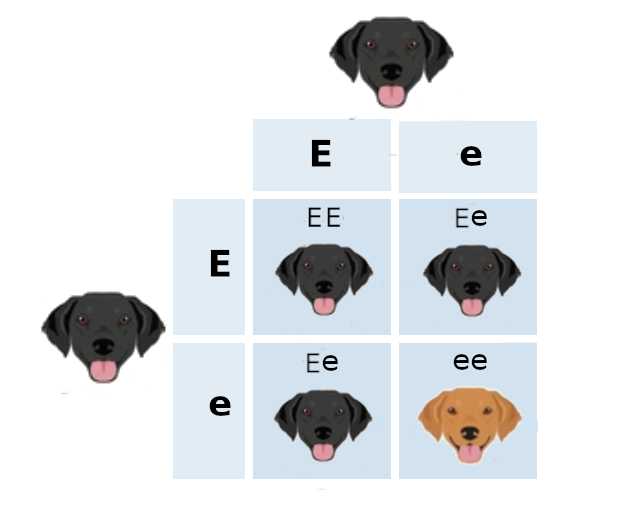
- Genotype of parents: Ee (carrier) x Ee (carrier)
- Possible genotypes of offspring:
- 25% EE (non-carrier)
- 50% Ee (carrier)
- 25% ee (yellow)
- Chance of producing yellow Labradors: 25%
- Chance of offspring being carriers of the E-locus gene: 50%
- Chance of offspring not carrying the E-locus gene: 25%
In this scenario, there is a balanced distribution of possible genotypes, with a significant portion of the litter being carriers of the e allele, which influences future breeding outcomes.
Crossing a Labrador That Is a Carrier of the E-Locus Gene with a Non-Carrier
When a Labrador that is a carrier of the E-locus gene (Ee) is crossed with a Labrador that does not carry the E-locus gene (EE), the resulting puppies will inherit one E allele from the non-carrier parent and either an E or e allele from the carrier parent.
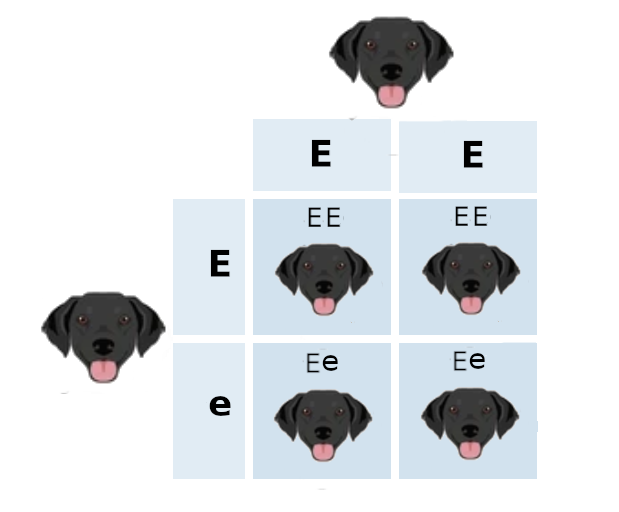
- Genotype of parents: Ee (carrier) x EE (non-carrier)
- Possible genotypes of offspring:
- 50% EE (non-carrier, black or chocolate)
- 50% Ee (carrier, black or chocolate)
- Chance of producing yellow Labradors: 0%
- Chance of offspring being carriers of the E-locus gene: 50%
In this cross, none of the offspring will be yellow since there is always at least one dominant E allele present, preventing the expression of the yellow coat color. However, half of the puppies will be carriers of the e allele, potentially producing yellow Labradors in future generations if bred with other carriers.
The Impact of the B-Locus on Labrador Coat Color
In addition to the E-locus, the B-locus gene affects Labrador coat color. The B-locus determines whether the pigment eumelanin is black or brown (chocolate). The B-locus has two alleles: B (dominant) for black and b (recessive) for chocolate.
- BB or Bb: Black coat color (if not masked by ee).
- bb: Chocolate coat color (if not masked by ee).
When considering the E-locus and B-locus together, the potential coat colors are:
- EE or Ee with BB or Bb: Black
- EE or Ee with bb: Chocolate
- ee (regardless of B-locus): Yellow
Understanding the interplay between these loci helps predict not just whether a Labrador will be yellow but also whether it will be black or chocolate if not yellow.
Genetic Testing and Breeding Practices
Breeders can use genetic testing to determine the genotypes of their Labradors, ensuring informed breeding decisions. Testing can identify carriers of recessive alleles, helping breeders avoid unintended coat color outcomes and maintain genetic diversity.
Benefits of Genetic Testing:
- Accurate Prediction: Helps predict the coat color of offspring.
- Health Screening: Identifies potential genetic health issues.
- Responsible Breeding: Encourages breeding practices that avoid genetic disorders and maintain the breed’s health.
Ethical Considerations in Breeding
Ethical breeding practices are crucial to maintaining the health and well-being of Labradors. Breeders should prioritize health, temperament, and breed standards over coat color preferences.
Key Ethical Practices:
- Health Screening: Regular health tests for genetic disorders common in Labradors.
- Avoiding Inbreeding: Maintaining genetic diversity to prevent hereditary issues.
- Transparency: Providing potential puppy owners with full genetic information.
FAQs about Labrador Coat Color Genetics
Addressing common questions can enhance reader understanding and engagement.
Common Questions:
- Can two black Labradors produce a yellow puppy?
- Yes, if both are carriers of the e allele (Ee).
- Why did my chocolate Labrador have yellow puppies?
- If bred with a yellow Labrador (ee), the resulting puppies could be yellow (ee).
- Is coat color linked to health or behavior?
- Generally, coat color does not affect health or behavior, though ethical breeding for temperament is essential.
Conclusion.
Understanding the genetics behind Labrador coat colors, particularly the role of the E-locus gene, helps breeders make informed decisions about breeding pairs. The E-locus gene, with its dominant (E) and recessive (e) alleles, significantly impacts whether the offspring will be yellow, black, or chocolate. By examining different crosses, we see that the presence or absence of the e allele determines the likelihood of producing yellow Labradors and carriers of the E-locus gene. This genetic insight ensures that breeders can predict and influence the coat color outcomes in their litters, maintaining the desired traits and diversity within the breed.
